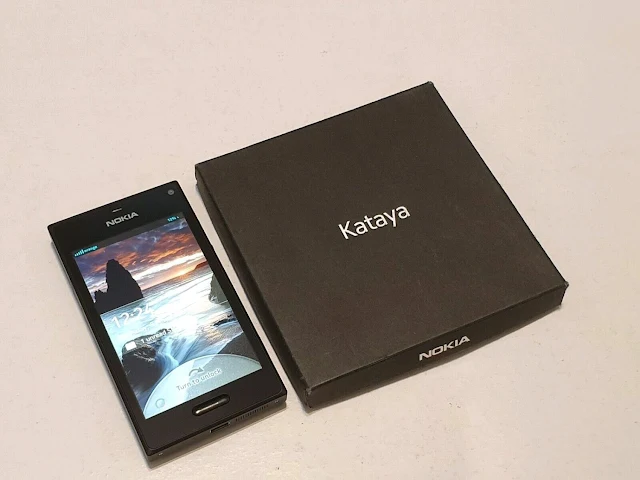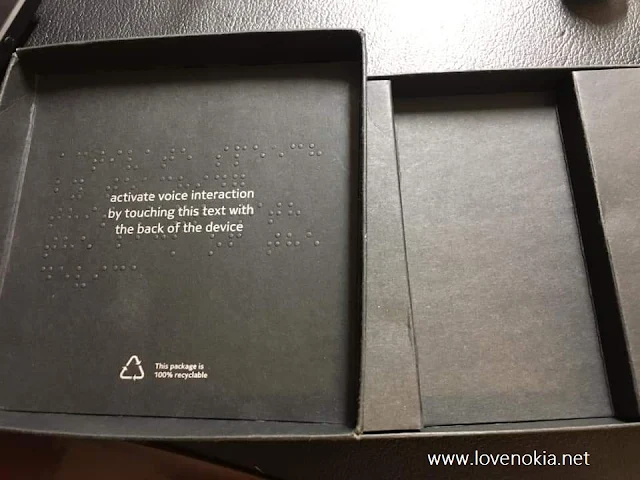Nokia fan Dimitrios Vlachos shares his findings - THE KATAYA, EXPOSED: A 2000 words ode to Nokia’s Golden Age

- Do you remember the Nokia Kataya handset, that leaked in late June 2019? Almost a year later and there are still lots of questions yet to be answered.
- Which year was Kataya manufactured? Is it a Nokia X predecessor? Why does it have a retail box, while being a prototype? What OS does it run on? Is it Google’s Android? Maybe a custom ROM? A fork? Is it a lost in time version of Nokia’s homegrown MeeGo OS? Or, is it a different, mysterious Meltemi phone?
- The latter is what I firmly believe. In order to reinforce this, I have gathered some clues from Nokia employees that worked on Project Meltemi. Then, I tried to connect them with the available Kataya information, to see if they coincide.
- In short, I think Nokia Kataya is Meltemi based. Below you will find why (please read twice the bold-underlined phrases).
- There was [an] internal battle between Oulu and Copenhagen about which site gets to do Meltemi UI development. Eventually, Oulu won and that is the main reason why Copenhagen office was closed in 2011.
- Meltemi started on top of the latest public Qt-QML [very high-level Qt framework] version. In summer 2011 it shifted to Qt5-QML2, which both were publicly announced in December 2012. [Thus] it would be part of the Qt ecosystem.
- It has been very difficult to get any information about the project, as many of those involved declined to comment. Meltemi employees formed a very close group and still do [mid-2015]. Some people still feel the duty to take the secret to the grave with them. [Also,] Nokia has never confirmed that it existed and still does not. [There is] the impression that Nokia still wants to keep its employees’ lips sealed.
- The goal was to create a device that could be classified as a smartphone, but which had as its key selling point an attractive user experience, instead of relying on an ecosystem. When it comes to UI, Meltemi was probably the most design-driven product that has ever existed in Nokia. [It had] a very artistic layout.
- Meltemi UI consisted of the “Apps” (grid with squircle shaped icons like in N9) and “Recent” (similar to the Asha UI Fastlane) pages. [Regarding the latter,] one of the key selling points in [...] Meltemi phone was called “Journal”. [This] app automatically created a timeline of everything you [recently] did: calls, texts, photos, calendar events, social updates etc.
- [In its final phase, Meltemi was going] not to use widgets at all.
- [There was the] mandatory 1 second app start time requirement: With proper transition animations those seconds are not as bad as they sound and the UI feels fluid.
- The [Meltemi] phone would be built upon new hardware.Nokia [wanted] to obtain low-cost smartphones to compete with Android phones [...] for developing markets. The name Meltemi would have remained unknown to the wider public. [Nokia] had a new Asian name under work, like Asha, as the markets were assumed to be in Asia.

- Kataya writes on its back “Designed in Oulu”. This is a clear hint.
- On the one side of the Kataya box, it can be found a Qt logo along with the sentence “Built on Krakatau”. If Kataya was indeed built upon Meltemi, “Krakatau” could have been an internal UI codename.
- This one is undoubtedly true. I tried contacting both the Kataya first owner and the eBay buyer for more info on the phone. However, both declined to comment, with the latter telling me that the “Kataya is extreme rare”. Chances are he might be connected in some way with Nokia, as his YouTube channel is full of Nokia prototypes videos. Moreover, this should definitely be the reason why we had learn nothing about it until 2019.
- When it comes to Kataya UI, even the original seller stated that “OS isn’t similiar to any Nokia ever made [featuring] new icon styles [and] animations.” The whole UI is full of Skeuomorphic Design elements (icons, menus, buttons, toggles, etc.) and it visually resembles the first six versions of Apple’s iOS (icons, settings menu, statusbar layout etc.). And we certainly know that Apple used this design language until mid 2013 to create an attractive, rich user experience featuring a fluid interface. Why Nokia not doing the same? Also, many argue that there have been three main interfaces under consideration, while others speak of four or more alternatives. So, the Kataya UI may be one of these.
- On the leaked Kataya images, we can clearly see two main UI pages, indeed; the Homescreen and the Recent Actions (this one can only be found on an image uploaded by LoveNokia at 14 August 2019 - see “The References” section). This Recent page resembles the FastLane in some way, which itself seems to be a kind of successor to Nokia’s Journal internal app.
- Although in its first phase (~2011) Meltemi was fundamentally based on widgets, these where totally dropped in more recent builds. And, if I recall correctly, there is not a single suspicion of widget usage in Kataya UI.
- Surely one of the strongest arguments in there. If there is one prominent element in every aspect of the Kataya OS, this is the animations’ “collection”. A semicircle rolling to unlock, the transition from lock screen to home mimicking a theatrical stage curtain, icons zooming in and out when launching and exiting an app respectively, are only minor examples of these animations (found in the LoveNokia’s video - see “The References” section).
- Indeed the Kataya hardware is “brand new”, as there hasn’t made its appearance on another Nokia handset beforehand (no pun intended).

- Start with Asha name. Asha is a developing province in India, as far as Google Maps tell the truth. They also say that Kataya is also such an Indian province close to Asha. Remember that India has always been a massive consumer electronic market, where a phone “made for the developing countries” could have targeted.
- It is true that Kataya states it was “Designed at Oulu”. But does this refer to the device’s Software, or Hardware? Also, on startup a strange “Tampere powered” logo appears, which possibly is where the Kataya OS was developed.
- Don’t forget that both Symbian and MeeGo were able to run Qt apps, along with Meltemi.
- For this one, sorry, I couldn’t come up with a counter-argument.
- The “design-driven” and “very artistic” characterizations are surely general and could have been referring to, let’s say, the MeeGo Harmattan UI as well. Just recall how fluid the Swipe UI felt back on these days. Also, the “attractive user experience” is more than subjective.
- These “squircle-shapes” icons resemble the N9 ones. Personally, I would describe Kataya icons as “mostly boxy”.
- No counter-argument for this clue by my side, either.
- Transition animations when launching an app complies with this Meltemi requirement, but why also present on lock screen and within the app pages? Only logical explanation would be the UI consistency, in order to “hide” this 1 second workaround.
- The new Meltemi hardware consisted of “Clipper, Goa and Zhora” devices. Images from Clipper have leaked (and is different from the Kataya, having either as model number the RM-784 or RM-792), and we know that the latter two resembled the Asha 501 and the Lumia 920 respectively. From this perspective, the Kataya could only be the Goa. But there are little similarities between the Kataya and the Asha 501. Also, the 501 has RM-902 and the 920 RM-821 as model numbers, while the Kataya has RM-842. This is very close to the Nokia Asha 309 (RM-843), with which has absolutely no connection with the former. External, at least.
- This might feel a strong proof, however, the Kataya feels far more premium than a budget 50€ smartphone. Just see the metal-crafted Nokia logo in the back, or the “smart” box that enables Voice Interaction activation with a single touch. Also, Wikipedia tells me that Kataya is located somewhere in Nepal and not in India.
- Is Kataya a Meltemi phone? To my mind, of course YES. All the clues and arguments above converge into. The counter-arguments are so little to convince me the opposite.
- I want to be clear; this post doesn’t introduce any breaking information, nor it is totally objective-true. But it doesn’t pretend to be. It provides just some “food for thought” for anyone interested in the Nokia Kataya.
- I read somewhere that, around 2012, the Nokia Meltemi team was alright copying the iPhone openly. I just couldn’t recall the web source; that’s why I didn’t quote it in “The Clues” section. For me, this would be the ultimate proof, as Kataya’s both Hardware and Software are cloning the iPhone in a way.
- I also read a series of articles stating that “Nokia had iPhone-like prototype in 2004, but killed it” (see “The References” section). Just imagine this prototype being the Kataya. It is known that Apple copied some XEROX PARC ideas about the GUI in order to create the Macintosh. Taking all these under consideration, am I typing this post through my Kataya 11 Pro Max?!?
The References:
https://www.lovenokia.net/2019/07/kataya-unknown-nokia-with-unknown-os-built-on-krakatau.html?m=1
https://www.lovenokia.net/2019/08/video-nokia-kataya-phone-with-coolest-ui-in-action.html?m=1
https://nokiamob.net/2019/06/29/nokia-kataya-prototype-with-unknown-os-selling-on-ebay/
https://community.phones.nokia.com/discussion/49076/what-on-earth-is-built-on-krakatau
http://mynokiablog.com/2014/11/25/mythbusting-nokias-meltemi-part-1-n9-elop-android-safest-best/
http://mynokiablog.com/2015/08/19/mnb-rg-meltemi-story-part-iii/
http://mynokiablog.com/2014/12/08/unreleased-meltemi-proto-nokia-clipper/
https://asokan.org/operation-elop/Operation%20Elop%20-%20Pekka%20Nykanen%20&%20Merina%20Salminen.pdf (The “Operation Elop” book is an English translation of the original, Finnish “Operaatio Elop”.)
https://www.mac-history.net/computer-history/2012-03-22/apple-and-xerox-parc
***Original article composed at 4/3/2020. Last edited at 14/6/2020. Websites accessed at 9/3/2020. If unavailable, please check out Wayback Machine.
Thanks, Dimitrios Vlachos for your efforts and sharing this article with us. :)
If any of you have something interesting to share about Nokia (your Nokia story, your experience, how you became a Nokia fan, your dream Nokia phone, etc) we would love to feature your article on our blog. Just send it to us on Twitter, Facebook or using the Contact Form. :)

Comments
Post a Comment